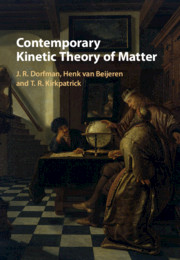Book contents
- Frontmatter
- Dedication
- Contents
- List of Figures
- List of Tables
- Acknowledgements
- Nomenclature
- 1 Introduction
- 2 The Boltzmann Equation 1: Fundamentals
- 3 The Boltzmann Equation 2: Fluid Dynamics
- 4 Transport in Dilute Gas Mixtures
- 5 The Dilute Lorentz Gas
- 6 Basic Tools of Nonequilibrium Statistical Mechanics
- 7 Enskog Theory: Dense Hard-Sphere Systems
- 8 The Boltzmann–Langevin Equation
- 9 Granular Gases
- 10 Quantum Gases
- 11 Cluster Expansions
- 12 Divergences, Resummations, and Logarithms
- 13 Long-Time Tails
- 14 Transport in Nonequilibrium Steady States
- 15 What’s Next
- Bibliography
- Index
3 - The Boltzmann Equation 2: Fluid Dynamics
Published online by Cambridge University Press: 18 June 2021
- Frontmatter
- Dedication
- Contents
- List of Figures
- List of Tables
- Acknowledgements
- Nomenclature
- 1 Introduction
- 2 The Boltzmann Equation 1: Fundamentals
- 3 The Boltzmann Equation 2: Fluid Dynamics
- 4 Transport in Dilute Gas Mixtures
- 5 The Dilute Lorentz Gas
- 6 Basic Tools of Nonequilibrium Statistical Mechanics
- 7 Enskog Theory: Dense Hard-Sphere Systems
- 8 The Boltzmann–Langevin Equation
- 9 Granular Gases
- 10 Quantum Gases
- 11 Cluster Expansions
- 12 Divergences, Resummations, and Logarithms
- 13 Long-Time Tails
- 14 Transport in Nonequilibrium Steady States
- 15 What’s Next
- Bibliography
- Index
Summary
Integrations of the Boltzmann equation lead to conservation equations for the local fluid densities. The mean free path, l; of the gas particles is assumed to be small compared to the size, L of the container. When the gas is close to local equilibrium, solutions to the Boltzmann equation are obtained by expressing conserved currents as series in powers of the gradients of the local variables starting with the local Maxwell-Boltzmann distribution. Higher terms are obtained by inserting the series in the Boltzmann equation and collecting terms of equal order. This, together with the conservation equations, leads to hydrodynamic equations. The ideal fluid equations are obtained to lowest order, and the next order is the Navier-Stokes equations, with explicit expressions for the transport coefficients, which are compared with experimental results for different model potentials. To second order the rate of entropy production agrees with predictions of non-equilibrium thermodynamics.
Keywords
- Type
- Chapter
- Information
- Contemporary Kinetic Theory of Matter , pp. 60 - 122Publisher: Cambridge University PressPrint publication year: 2021

